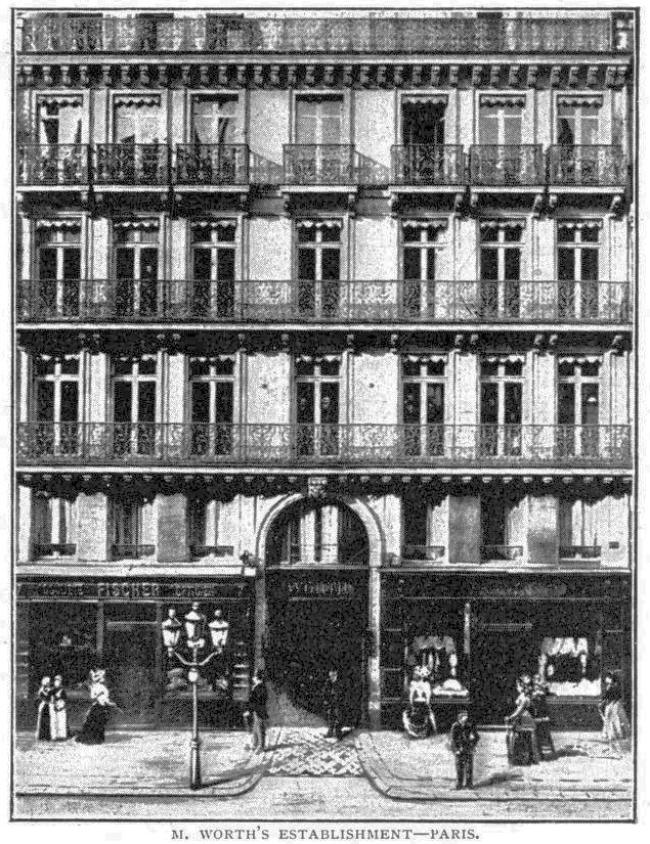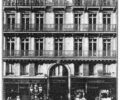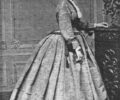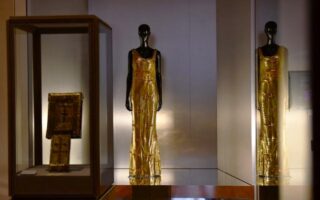Charles Worth: The Man who Invented Haute Couture


- SUBSCRIBE
- ALREADY SUBSCRIBED?
BECOME A BONJOUR PARIS MEMBER
Gain full access to our collection of over 5,000 articles and bring the City of Light into your life. Just 60 USD per year.
Find out why you should become a member here.
Sign in
Fill in your credentials below.
Place Vendôme, Rue de la Paix, Rue du Faubourg Saint Honoré – these streets are the epicenter of Paris’s high fashion industry. International designer names such as Céline, Gucci and Dolce and Gabbana sit cheek-by-jowl along some of the most exclusive shopping streets in the world. But behind the storefronts, the creators of these very desirable clothes are the inheritors of a fashion industry invented more or less single-handedly by one man in the 19th century.
And not just any man: an Englishman, no less. Charles Frederick Worth was born in 1825 in a small village called Bourne in Lincolnshire, eastern England. His father was a solicitor but what should have been a comfortable middle class childhood for Charles was ruined by his father’s drinking and irresponsible loss of the family’s money. His wastrel behavior meant Charles was apprenticed to a printer at the age of 11. A year later he moved to London to work for the drapery store Swan & Edgar. It was during this apprenticeship that Worth learnt the skills of salesmanship and catering to affluent ladies, and no doubt developed his eye for color and fabric.
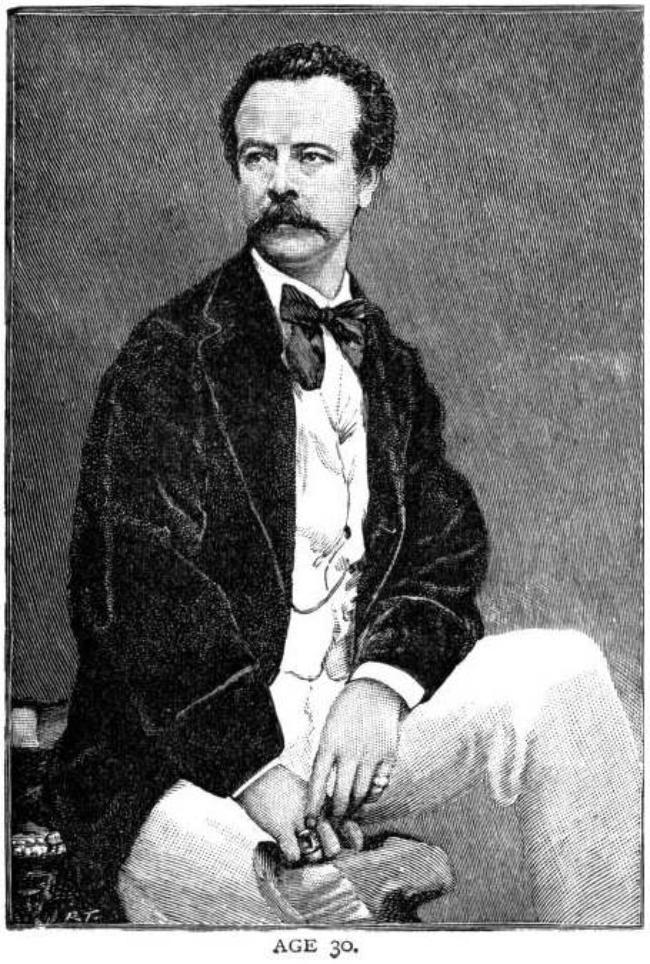
Engraved portrait of Charles Frederick Worth, fashion designer, aged 30 (in 1855). Author unknown/ Wikimedia Commons
But Worth was ambitious and knew there was a wide world out there, and in 1846 he crossed the English Channel for Paris, where he found work with the prestigious silk merchant company Gagelin. Gagelin supplied the French Court with silks for court outfits as well as selling cashmere mantles and shawls, and Worth started to come into contact with the highest levels of French society. It was while working at Gagelin that Worth started to sew his own dresses, and once he had met his future wife and married her (another employee at Gagelin, Marie Vernet), she became his model.
His gowns sold so well that Gagelin eventually allowed Worth to open his own dress department. Success came quickly: Worth’s gowns were displayed at London’s Great Exhibition of 1851 and again at Paris’s Universal Exhibition of 1855. Three years later he felt sufficiently confident to open his own business in partnership with a Swede, Otto Bobergh. Aiming high from the start, the House of Worth opened in Rue de la Paix.
It is said that success is built on hard work but that alone means nothing without a hefty dose of good luck. Worth’s dose of good luck arrived in the form of Princess Pauline de Metternich, wife of the Austrian Ambassador. She was a regular customer at Worth and it was while wearing one of his creations at a Court ball that she was noticed by the Empress Eugénie, wife of Napoleon III, who enquired where it had come from. Immediately, Eugénie summoned Worth to see her and overnight he became her favored dressmaker. Her name became synonymous with Worth’s designs. In her memoirs, Pauline de Metternich ruefully noted “And so…Worth was made and I was lost, for from that moment there were no more dresses at 300 francs each”.
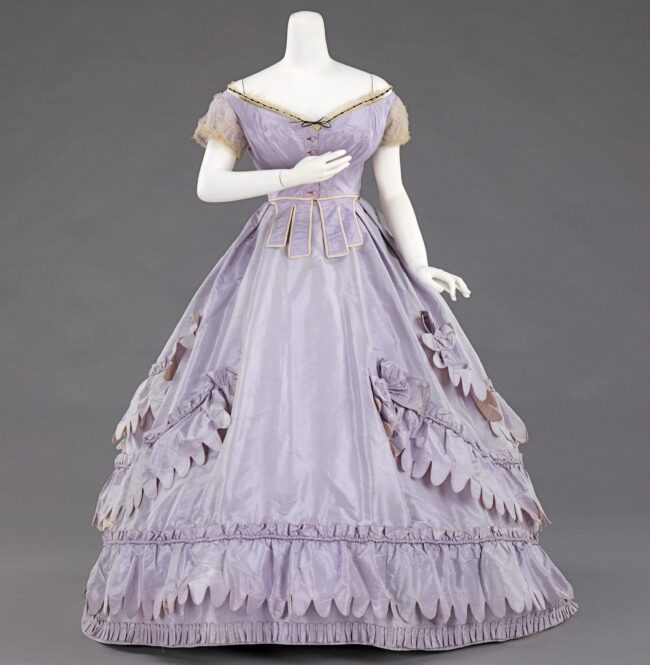
Evening ensemble by Worth. 1862-1865. MET/ Wikimedia commons
Between them Eugénie and Worth dictated the style and silhouette of fashionable clothes for more than a decade. Throughout the 1860s the crinoline became bigger and wider. Although the cage was made from flexible steel or bamboo hoops which would fold to facilitate sitting down and going through doors, by the end of the 1860s its sheer circumference made gowns impractical. By 1870 Worth was designing gowns based on the bustle – a more manageable cage that moved the bulk of fabric to the rear and kept the front straight and relatively simple. At Eugénie’s request he also shortened hemlines to ankle-length (she liked going on long walks). Not an earth-shattering change you might think, but controversial enough for conservative newspapers to have a collective attack of the vapors.
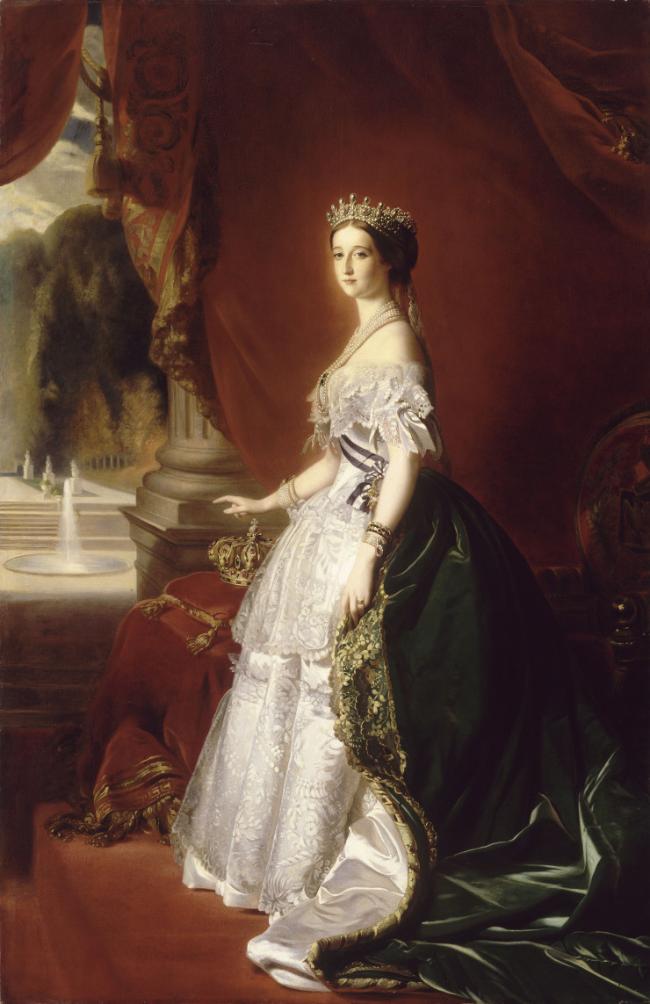
Portrait of Empress Eugénie in Court Dress. Anonymous. After Franz Xaver Winterhalter. Wikimedia Commons
Worth revolutionized dressmaking and virtually invented the modern fashion industry. Whereas before, a (female) dressmaker would visit a client in her home and make up a garment to her exact wishes, Worth summoned his clients to his premises in Rue de la Paix where he showed them a range of his designs to choose from. He was the first to use live models, starting with his wife Marie; before, dressmakers used dolls to illustrate the designs. And he was a great marketer – he was the first to sew labels bearing his name inside his clothes, and used celebrity women to show them off.
Instead of Marion Cotillard, Cate Blanchett or Margot Robbie, think Sarah Bernhardt, Lilly Langtry and Dame Nellie Melba, who would wear them to lavish opening nights. The vast majority of sewing was still done by hand, but the recent patenting of the sewing machine allowed long seams to be mechanically stitched which obviously saved time.
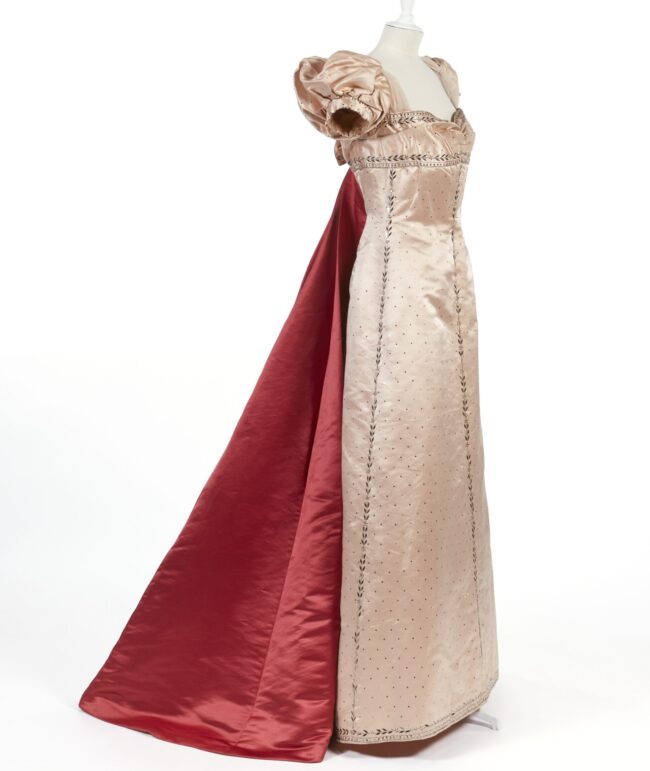
Evening dress in satin, style Empire, 1892. Worth, couturier. Paris Musées Collection. Wikimedia commons.
Throughout its existence the House of Worth was synonymous with lavish fabrics and trimmings but although Worth was a couturier, creating made-to-measure garments to fit individual women, he also pioneered the concept of “diffusion lines” and prêt-à-porter by selling ready-made versions of his couture outfits in the shop, and he introduced the idea of twice-yearly collections. He franchised his patterns and fashion plates – an early prototype for modern brand licensing.
Worth also pioneered the image of the fashion designer as an eccentric diva. He dressed “artistically,” wearing a beret-style hat, fur-trimmed cape and cravat and had an imposing mustache. He was not afraid to impose his ideas on his wealthy and influential clients, more or less dictating to them which colors and trimmings they should have.
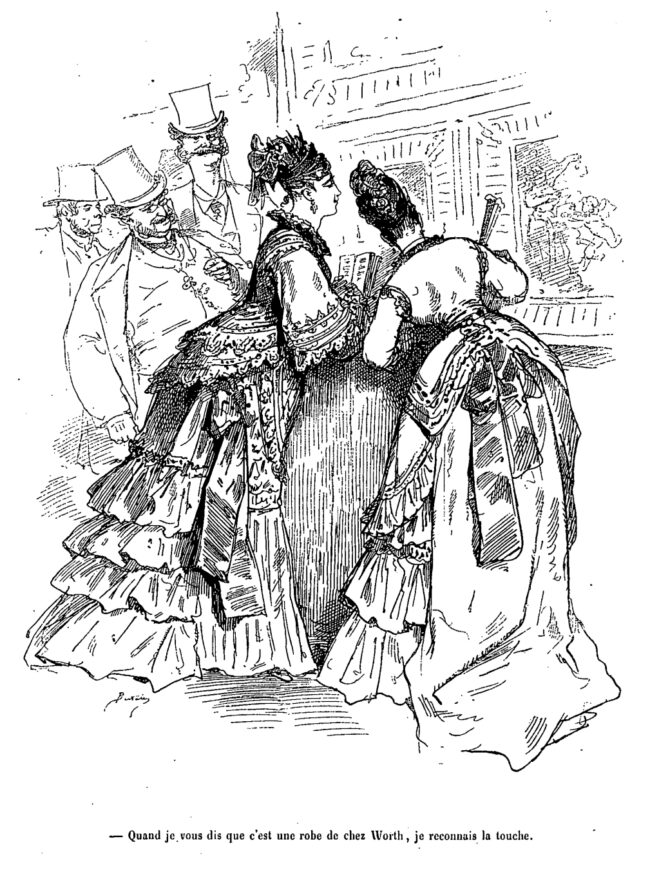
“Quand je vous dis que c’est une robe de chez Worth, je reconnais la touche.” “When I tell you that it’s a dress from Worth, I recognize the touch.”) Illustration by Bertall paru in La Comédie de notre temps, 1875. Public domain
Although Eugénie and her husband were banished into exile after the catastrophic Franco-Prussian War of 1870, Worth’s acute business sense enabled him to prosper. During the economic downturn of the 1880s, he turned his attention to cultivating a new generation of wealthy American clients such as the Rothschilds and Vanderbilts. From the mid-1870s his sons became increasingly involved in the running of the house, which they continued to do successfully well into the 20th century. But Worth remained closely involved and continued to influence fashion design. He altered the bustle shape to a more streamlined, waistless “princess” silhouette in the mid-1870s, then back to a shelf-like mass of fabric at the rear in the 1880s. His pioneering couture house was followed by numerous others in the latter years of the 19th century: Paquin, Callot Soeurs, Jacques Doucet, Vincent to name just a few, establishing Paris as the modern capital of luxury fashion.
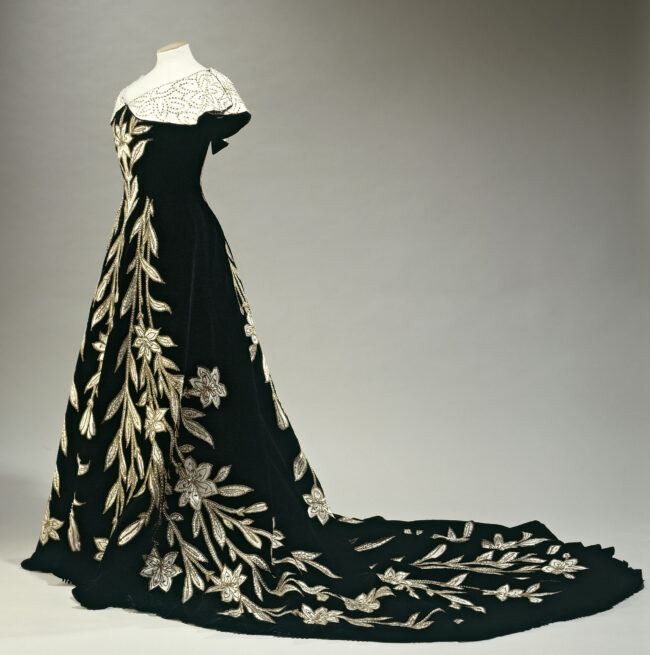
Evening gown in black velvet and silk, 1896. Paris Musées Collection. Wikimedia commons
Worth died of pneumonia in 1895, by now an extremely wealthy man and known as a collector of “artistic curiosities.” His sons, and later his grandson, carried on the traditions of the House of Worth; in fact the last decade of the 19th century and the first of the 20th century were probably its most successful period. Shops opened in the ultrasmart resorts of Cannes and Biarritz as well as London, and clients could place their orders by telephone – the technological marvel of the age and comparable in terms of convenience to the advent of online shopping in the 21st century. Of course, only the very wealthiest people in 1900 would have a telephone in the first place. The house closed in 1952. By then it had amalgamated with Paquin but when Worth’s grandson retired there was no one else to carry it on.
Charles Worth’s life is one of remarkable achievement, from an impoverished childhood in an obscure English village to dressing the most famous, wealthy women on both sides of the Atlantic Ocean. And remarkably, whether you like it or not, it was a man who revolutionized the female-dominated industry of dressmaking, in the process laying the foundations of the modern million-dollar business of high fashion.
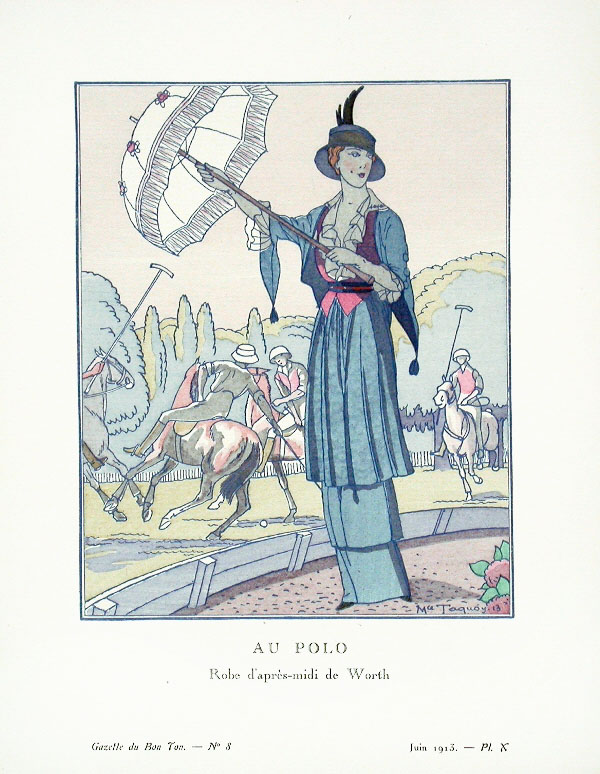
“Au polo. Robe d’après-midi de Worth.” At the polo match. Afternoon dress by Worth.) La Gazette du Bon Ton, 1913. Public domain
Lead photo credit : Portrait of Charles Frédéric Worth by Nadar. Médiathèque de l'Architecture et du Patrimoine. Public domain
More in fashion, haute couture
